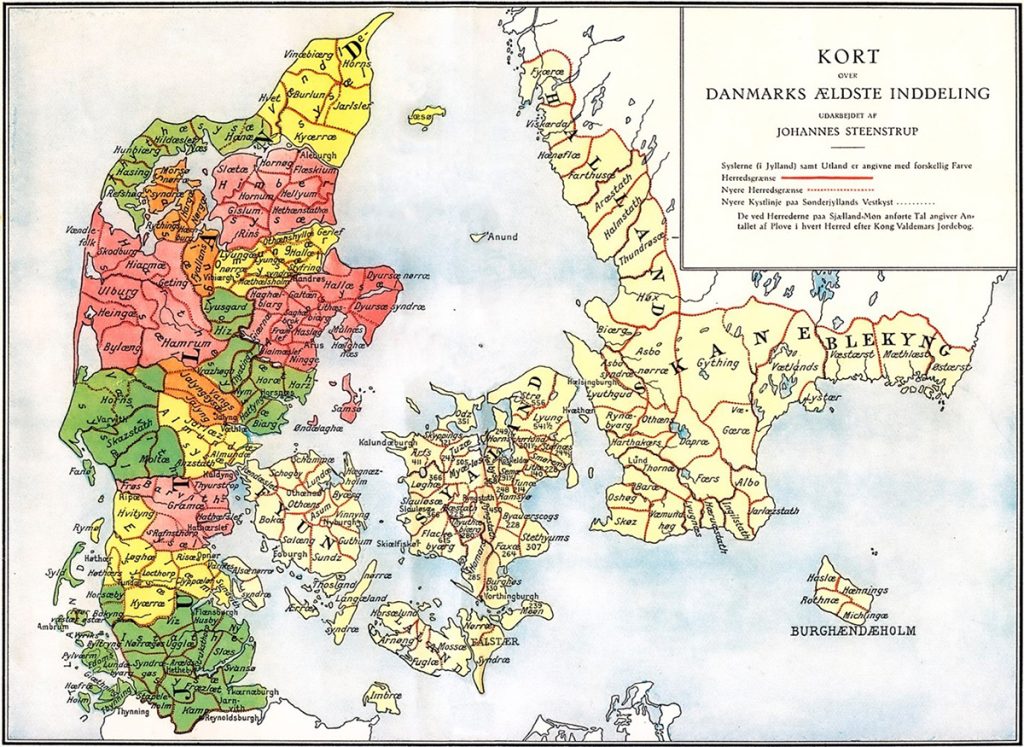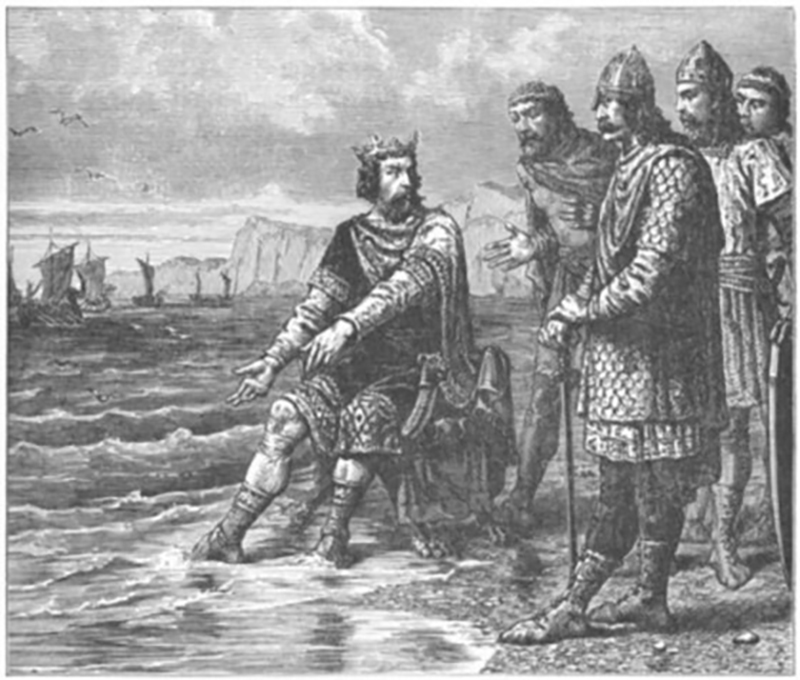Lars Kjaer
In the second half of the twelfth century the kingdom of Denmark, and the role of the secular elite, was utterly transformed. In this blog post I would like to look at a strange pseudo-legal text from the 1180s, Lex castrensis – ‘the law of the retainers’ – purporting to be a translation of a law code issued by the great viking ruler Cnut the Great (r. 1016-35), and what it reveals about the ways in which the aristocracy sought to adapt, and adapt to, the changing political circumstances, and how they imagined their role in ensuring the future welfare of the realm.
Medieval Denmark was an elective monarchy. As Björn Weiler has reminded us, an elective element was central to the succession in many medieval polities, but in Denmark the elite seems to have exercised a particularly high degree of agency and, often, to have had a real and meaningful choice.
Elections took place at the three regional assemblies, the thing, at Viborg in Jutland, Ringsted in Zeeland and Lund in Scania. The assemblies were certainly not, as national-romantic historians liked to imagine in the early twentieth century, democratic institutions in a modern sense: it was above all the elite who dominated, men like the magnate Esbern Snare who according to a contemporary chronicle, was a ‘man of great prudence and wealth, whose speech was listened to with happiness in the meetings of kings and princes’. Nevertheless, the chronicles also show that lesser members of the elite, the free peasants, were able to influence events, by acclaiming loudly, interrupting, or ignoring speakers – a reflection of the fact that the aristocracy still shared power with a large, wealthy and self-confident ‘middling’ elite of lesser landowners.

One factor was central to giving the assemblies a meaningful choice: the wide selection of candidates, all male members of the royal family could stand for election and since the Danish kings up to the twelfth century had been keen polygamists this meant that there could be up to half a dozen plausible candidates at any one time. At the assemblies, the elite would cluster in parties, but there also seems to have been large groups of undecided ‘swing voters’ whose votes were, as the chronicler Saxo Grammaticus complained, ‘unpredictable’, more positively, Saxo admits that at the assembly royal candidates character and suitability would be subjected to ‘penetrating scrutiny’.
In 1165 King Valdemar I (r. 1157-82) broke with this tradition. During a campaign to Rügen, he had his three-year old son Cnut VI elected as co-king. A practice that had not been seen in Denmark since the age of Cnut the Great. The election was, in practice, a breach with the elective monarchy. Valdemar’s many cousins lost any hope of succeeding him as ruler, while the peasant and aristocratic elite in Jutland, Zeeland and Scania were deprived of the opportunity to exercise the right to speak for and against a king at the assembly. The rest of Valdemar I’s reign saw the king increasingly isolated, haemorrhaging support from the rest of the royal family, who are no longer found among the witnesses to his charters. Worse than that, he was caught in a spiral of conspiracy and persecution with the other members of the royal family. Valdemar won, and destroyed his rivals, but lost the support that their networks had brought. Valdemar became increasingly reliant on a single family, the Hvide family of Zeeland, whom he rewarded generously, the rise of the Hvide family, in turn, sparked of a new series of disputes. By the end of his reign, Valdemar faced a civil war in Scania, which threatened to spread to Jutland.
When Cnut VI took over the kingdom in 1182 he seems to have adopted a policy of conciliation. Immediately after his father’s death, he journeyed to the assembly of Viborg, by opening his reign with an appearance at the traditional site which had had the first vote in royal elections, Cnut VI showed that he was intending to govern with more respect for the local rights and traditions of the kingdom. It is as part of this programme of reconciliation that our text, the Lex castrensis, should be read.
The author, Sven Aggesen, was himself a scion of the Danish nobility, of the so-called ‘Trund family’ of Scania. His uncle, Eskil had been archbishop of Lund and his father and grandfather had played key roles in the political struggles of the twelfth century, until they ran afoul of Valdemar I. To have Sven, one of the last surviving members of the Trund family of any standing, present a text at the behest of the king and his loyal archbishop, Absalon, was itself a declaration of a will to compromise and make peace: the former opponents had been let back into royal favour.
Sven Aggesen claims that his text is a rediscovered law from Cnut the Great’s time, which the archbishop and Cnut VI had asked him to expand and translate into latin. That is almost certainly false. The text is, as Mia Münster-Swendsen has shown, one that Sven had invented himself for the occasion: the elaborate creation story, however, gave it the lustre of antiquity and ancient Danish greatness.
Sven Aggesen explains that Cnut the Great had been troubled by the many disagreements that occurred within his vast band of retainers and had asked his wisest men to produce a law for the royal retainers. This law specified that all had to serve the king loyally ‘like limbs subject to one head’, but also specified how they were to avoid internal disputes, through respectful, courteous and mutually supportive behaviour. Crucially the law also bound the king and limited his powers, if he wanted to protect a retainer who broke the law, this was allowed, ‘as an act of clemency by the prince, but with this condition added: that he be entirely deprived of the support of his fellow-warriors and relieved of his former rights and duties under the law’. In other words: the Lex castrensis imagined a world in which the king did not disrupt the aristocracy’s own regulation and judgement of rights and wrongs, and did not – unlike Valdemar I – show undue favour to particular members of the elite. The relationship between king and aristocracy was to be governed by reciprocity:
‘Just as he laid down the pattern and rule of obedience for his men, so his own conduct should be gracious and familiar. Therefore it was enacted that the king … should himself display the loyalty he demanded from them. He should present a cheerful countenance, and deny none of them a courteous reception. He was also to give them the reward of their labour and pay his warriors their wages without delay or any kind of argument … Once they had received their pay, the men would show the same goodness and generosity in return towards their lords, and would be prepared to obey whatever commands they gave and not fail to carry out their orders. For the man who does not pay what he owes asks in vain for what he wants.’
Having set out the law, Sven goes on to explain how the Devil ‘tried to persuade the king to evade the law, so that once the head had been infected … the corrupting poison would spread through the rest of the limbs’. The logic of an organic societal model is followed through as the king appear also as the greatest danger to society, should the devil manage to ensnare him. The Devil pushes Cnut into murdering one of his retainers, probably a hint towards Valdemar I’s brutal conflicts with the aristocracy. In another text, Sven had noted that Valdemar had behaved ‘with more cruelty than was just towards his own’.
When the aristocracy discovered what the king had done, they were ‘convulsed with rage’ but made careful deliberations among themselves about what to do, they arrived at the conclusion that they could not do without the king, but that an example had to be set so that the king’s misdeed would not inspire others to do the same. The throne was placed in the middle of the assembly and the king ordered to prostrate himself before it, awaiting their judgement. Once the king had submitted, they absolved him of his crime but henceforth, no one was to be given respite, but expelled from the community of retainers ‘as an utter outcast’.
It is the retainers, all of them men of high aristocratic birth as Sven points out, who undertake to protect the kingdom from the danger of royal abuse of power and the corrupting influence of the Devil. They must serve the king valiantly but at the same time remain cautious of the ‘corrupt indulgence’ that would lead them to let the king get away with crimes.

Sven Aggessen’s text presents starkly both the potential of the new, stronger monarchy – promising a return to former greatness under rulers like Cnut the Great – and the diabolic dangers that threatened. In Sven’s vision for the future, the elite would continue to play a central role not only as the king’s obedient servants but also as potential judges, ready to cut of an infected limb should it become necessary. It was a role that, in many ways, continued the activities of evaluating – and taking action based on those evaluations – that their fathers had performed at the assembly sites.
Thus, I would suggest, the Lex castrensis cast a spotlight on the long, but shadowy, history of political thought among the medieval elite. A century later, in 1282, the Danish aristocracy would force Cnut VI’s successor, Erik V Klipping, to issue the first håndfæstning, a legally binding, written promise restraining royal power and promising to respect the rights of peasants, aristocrats and the freedoms of the Church. The thirteenth century is often seen as the starting point for political conflicts and debates in Denmark. Certainly – it is the first time that demands and ambitions are expressed in formats familiar to scholars of the history of political thought. Returning once again to a point made by Björn Weiler, however, we should remember that the rich narratives, pseudo-historical and didactic texts produced in the twelfth century are also full of political ideas, even if their format is unfamiliar. Listening closer to them we have a better chance of understanding how the medieval elite perceived itself and its role in the realm.
References
Eric Christiansen, The works of Sven Aggesen, twelfth-century Danish historian., London: Viking Society for Northern Research, 1992
Mia Münster-Swendsen, “The Making of the Danish Court Nobility: The ‘Lex castrensis sive curiae’ of Sven Aggesen Reconsidered”, in: Statsutvikling i Skandinavia i Middelalderen, ed.: Sverre Bagge et al., Oslo: Dreyers forlag, 2012, pp. 257-279.
Björn K. U. Weiler, Paths to Kingship in Medieval Latin Europe, c. 950-1200, Cambridge: Cambridge University Press, 2021.

